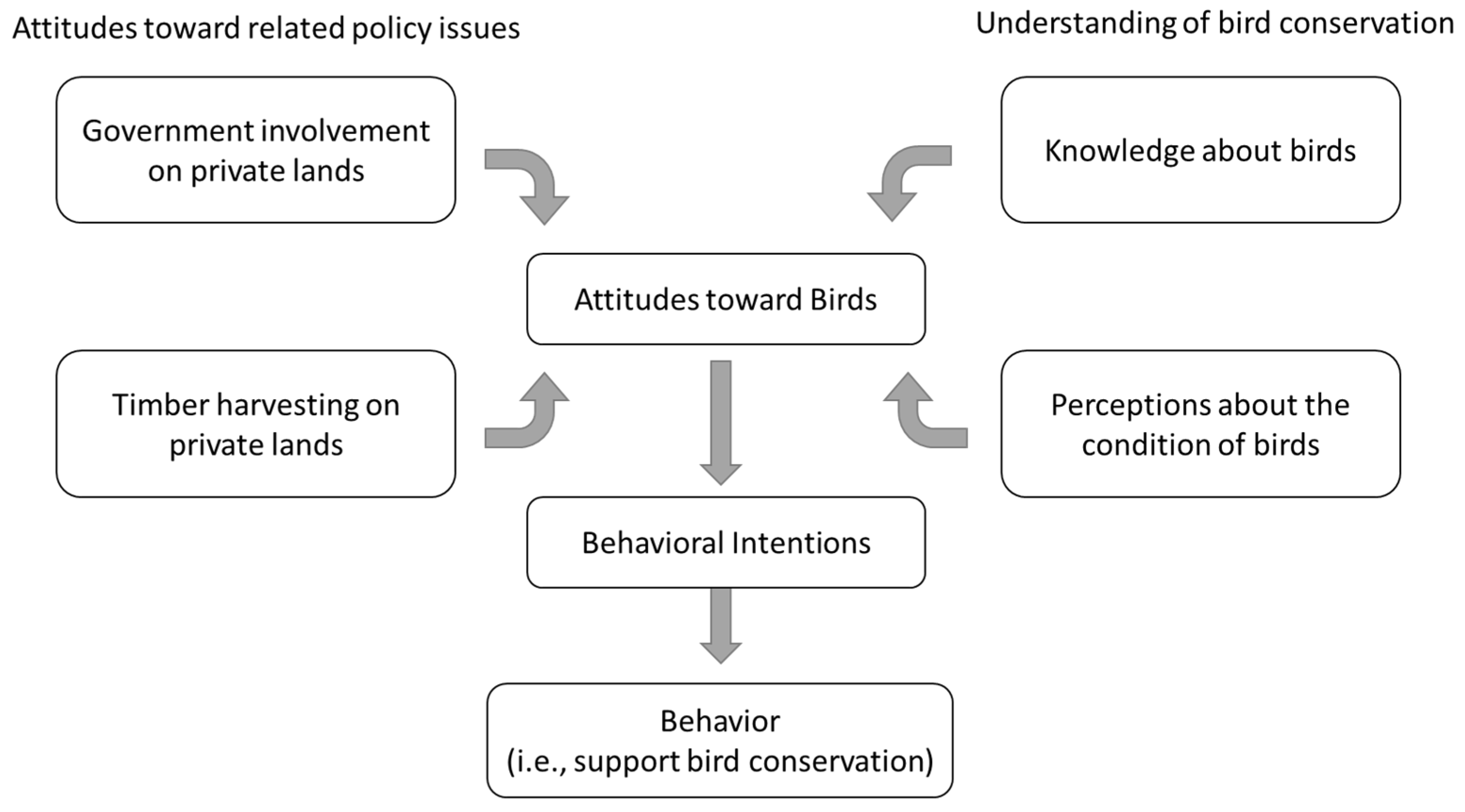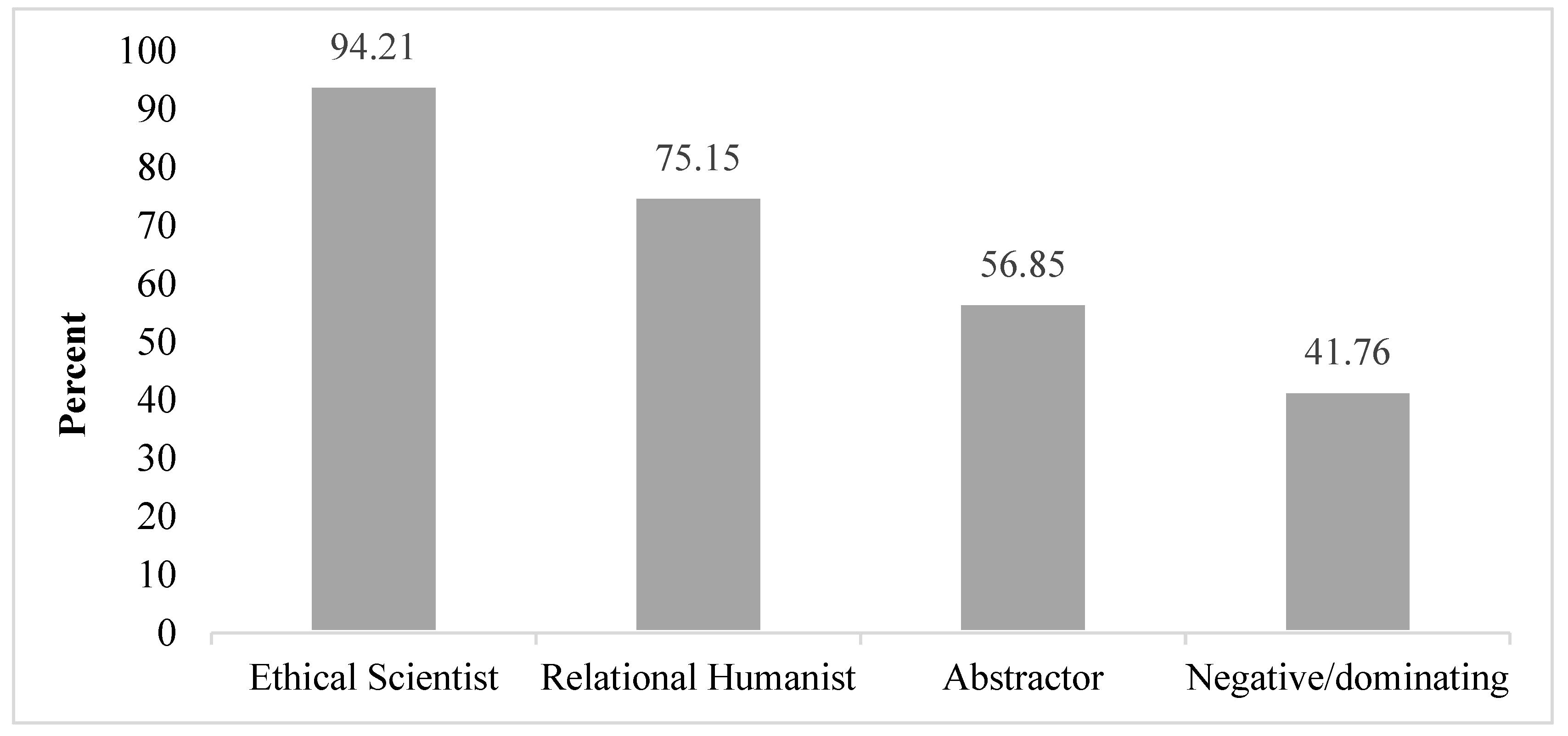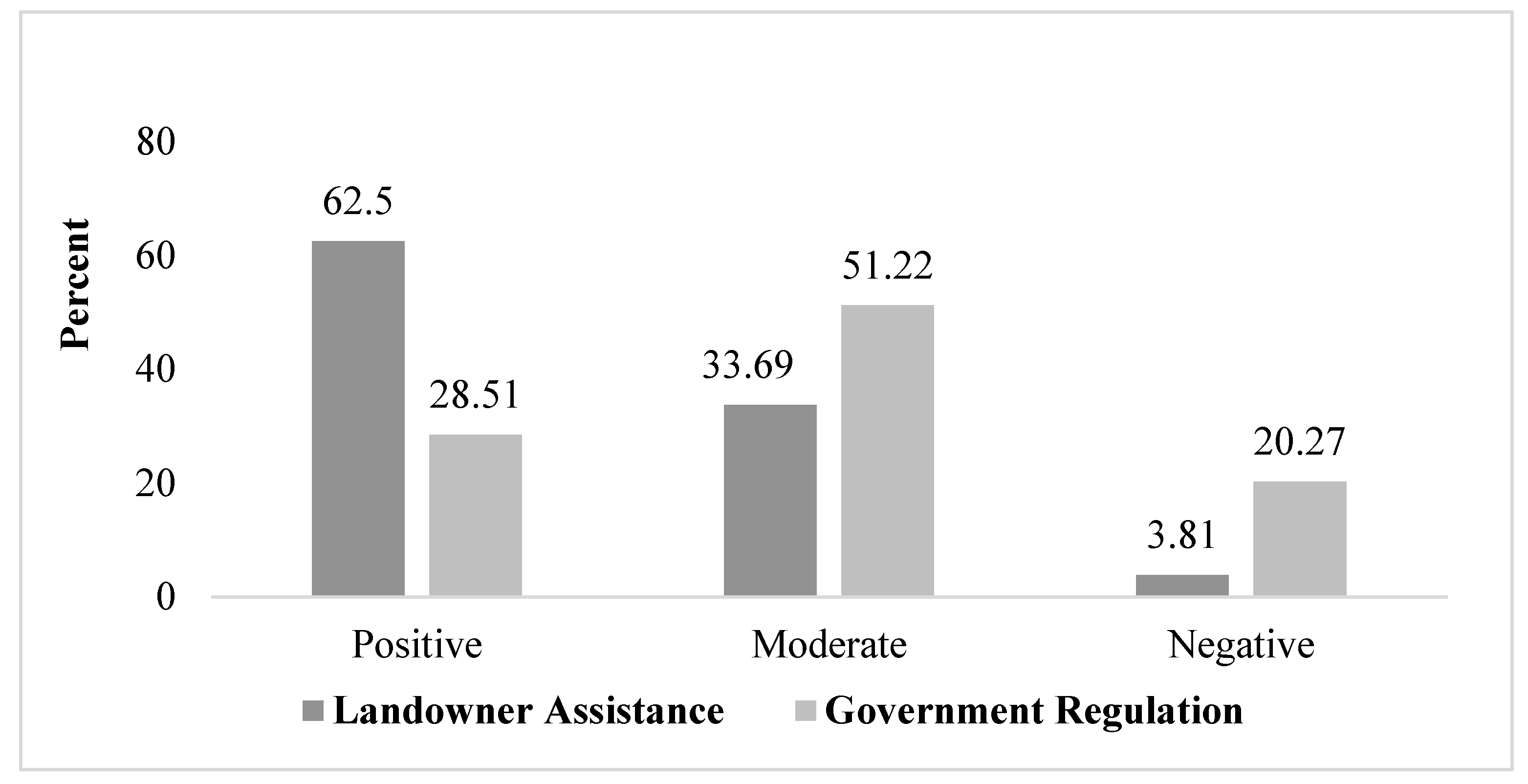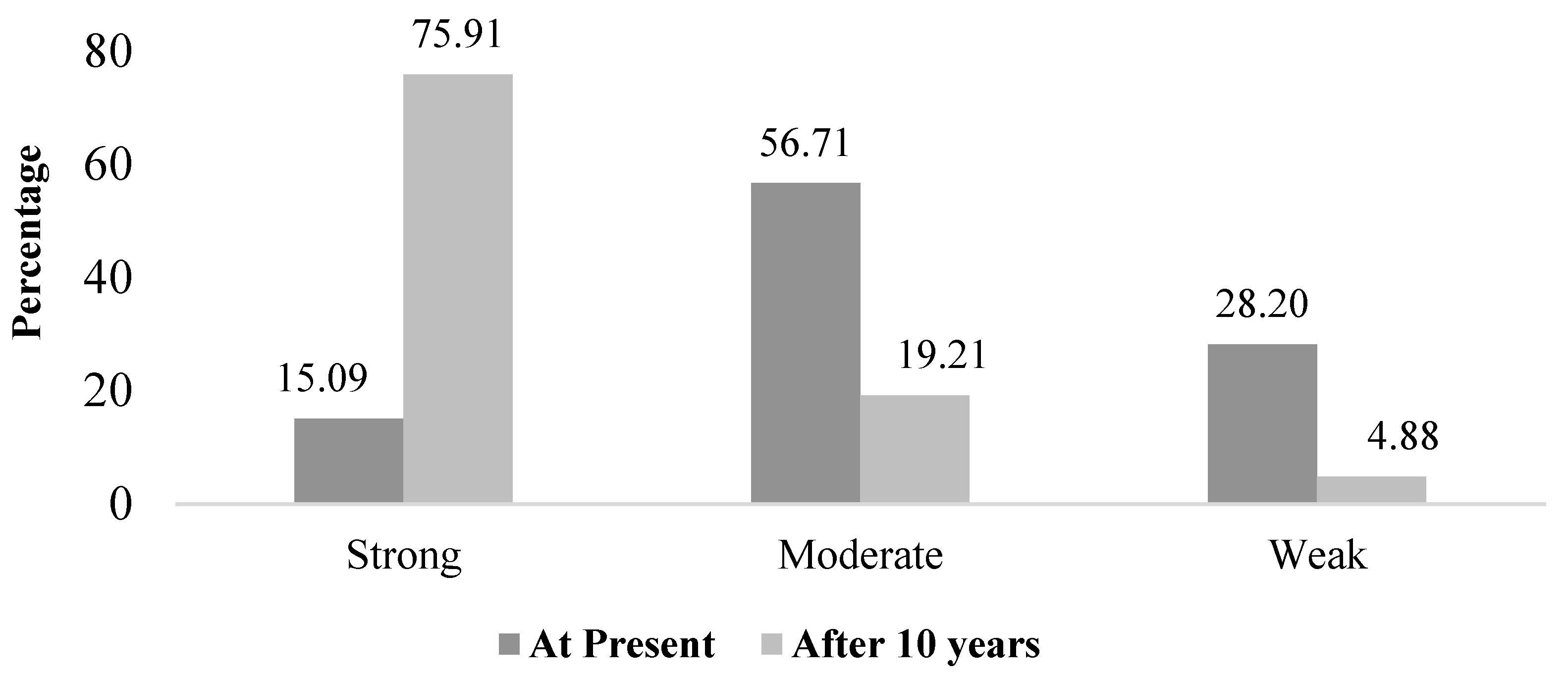Public Attitudes towards Birds and Private Forest Land Conservation
Abstract
1. Introduction
2. Materials and Methods
2.1. Approach
2.2. Data Collection and Analysis
3. Results
4. Discussion
5. Conclusions
Author Contributions
Funding
Institutional Review Board Statement
Informed Consent Statement
Data Availability Statement
Acknowledgments
Conflicts of Interest
References
- Brusatte, S.L.; O’Connor, J.K.; Jarvis, E.D. The Origin and Diversification of Birds. Curr. Biol. 2015, 25, R888–R898. [Google Scholar] [CrossRef] [PubMed]
- Rosenberg, K.V.; Dokter, A.M.; Blancher, P.J.; Sauer, J.R.; Smith, A.C.; Smith, P.A.; Stanton, J.C.; Panjabi, A.; Helft, L.; Parr, M.; et al. Decline of the North American Avifauna. Science 2019, 366, 120–124. [Google Scholar] [CrossRef] [PubMed]
- Bekoff, M. Compassionate Conservation and the Ethics of Species Research and Preservation: Hamsters, Black-Footed Ferrets, and a Response to Rob Irvine. J. Bioethical Inq. 2013, 10, 527–529. [Google Scholar] [CrossRef] [PubMed]
- Taki, Y.; Vincenot, C.E.; Sato, Y.; Inoue-Murayama, M. Genetic Diversity and Population Structure in the Ryukyu Flying Fox Inferred from Remote Sampling in the Yaeyama Archipelago. PLoS ONE 2021, 16, e0248672. [Google Scholar] [CrossRef]
- Stein, S.M.; Carr, M.A.; McRoberts, R.E.; Mahal, L.G.; Comas, S.J. Threats to At-Risk Species in America’s Private Forests; General Technical Report NRS-73; Department of Agriculture, Forest Service, Northern Research Station: Newtown Square, PA, USA, 2010; p. 20. [Google Scholar]
- Stauffer, G.E.; Miller, D.A.W.; Wilson, A.M.; Brittingham, M.; Brauning, D.W. Stewardship Responsibility of Pennsylvania Public and Private Lands for Songbird Conservation. Biol. Conserv. 2017, 213, 185–193. [Google Scholar] [CrossRef]
- Bengston, D.N.; Asah, S.T.; Butler, B.J. The Diverse Values and Motivations of Family Forest Owners in the United States: An Analysis of an Open-Ended Question in the National Woodland Owner Survey. Small-Scale For. 2011, 10, 339–355. [Google Scholar] [CrossRef]
- Kreye, M.M.; Adams, D.C.; Ober, H.K. Protecting Imperiled Wildlife Species on Private Lands: Forest Owner Values and Response to Government Interventions. Ecol. Econ. 2018, 149, 254–264. [Google Scholar] [CrossRef]
- McRoberts, R.E.; Mahal, L.G.; Carr, M.A.; Alig, R.J.; Comas, S.J.; Theobald, D.M.; Cundiff, A. Private Forests, Public Benefits: Increased Housing Density and Other Pressures on Private Forest Contributions; General Technical Report PNW-GTR-795; Department of Agriculture, Forest Service, Pacific Northwest Research Station: Portland, OR, USA, 2009; p. 795. [Google Scholar] [CrossRef]
- Deem, S.L.; Karesh, W.B.; Weisman, W. Putting Theory into Practice: Wildlife Health in Conservation. Conserv. Biol. 2001, 15, 1224–1233. [Google Scholar] [CrossRef]
- Lutter, S.H.; Dayer, A.A.; Heggenstaller, E.; Larkin, J.L. Effects of Biological Monitoring and Results Outreach on Private Landowner Conservation Management. PLoS ONE 2018, 13, e0194740. [Google Scholar] [CrossRef]
- Brock, M.; Perino, G.; Sugden, R. The Warden Attitude: An Investigation of the Value of Interaction with Everyday Wildlife. Environ. Resour. Econ. 2017, 67, 127–155. [Google Scholar] [CrossRef]
- Batt, S. Human Attitudes towards Animals in Relation to Species Similarity to Humans: A Multivariate Approach. Biosci. Horiz. 2009, 2, 180–190. [Google Scholar] [CrossRef]
- Tribe, A.; Booth, R. Assessing the Role of Zoos in Wildlife Conservation. Hum. Dimens. Wildl. 2003, 8, 65–74. [Google Scholar] [CrossRef]
- Maschinski, J.; Albrecht, M.A. Center for Plant Conservation’s Best Practice Guidelines for the Reintroduction of Rare Plants. Plant Divers. 2017, 39, 390–395. [Google Scholar] [CrossRef] [PubMed]
- Rydin, Y. Re-Examining the Role of Knowledge Within Planning Theory. Plan. Theory 2007, 6, 52–68. [Google Scholar] [CrossRef]
- Wynne, B. Risk and Environment as Legitimatory Discourses of Technology: Reflexivity Inside Out? Curr. Sociol. 2002, 50, 459–477. [Google Scholar] [CrossRef]
- Hew, K.F.; Cheung, W.S. Enhancing Students’ Learning of Factual Knowledge. In Using Blended Learning: Evidence-Based Practices; Hew, K.F., Cheung, W.S., Eds.; Springer Briefs in Education; Springer: Singapore, 2014; pp. 97–107. [Google Scholar] [CrossRef]
- Han, T.-I. Objective Knowledge, Subjective Knowledge, and Prior Experience of Organic Cotton Apparel. Fash. Text. 2019, 6, 4. [Google Scholar] [CrossRef]
- Johansson, M.; Laike, T. Intention to Respond to Local Wind Turbines: The Role of Attitudes and Visual Perception. Wind Energy 2007, 10, 435–451. [Google Scholar] [CrossRef]
- Breen, R.; Breen, R., Jr. Social Mobility in Europe; OUP: Oxford, UK, 2004. [Google Scholar]
- Koski, J.; Xie, H.; Olson, I.R. Understanding Social Hierarchies: The Neural and Psychological Foundations of Status Perception. Soc. Neurosci. 2015, 10, 527–550. [Google Scholar] [CrossRef]
- Eagly, A.H.; Chaiken, S. The Advantages of an Inclusive Definition of Attitude. Soc. Cogn. 2007, 25, 582–602. [Google Scholar] [CrossRef]
- Petty, R.; Ostrom, T.M.; Brock, T.C. Cognitive Responses in Persuasion; Psychology Press: New York, NY, USA, 2014. [Google Scholar] [CrossRef]
- Lucarelli, C.; Mazzoli, C.; Severini, S. Applying the Theory of Planned Behavior to Examine Pro-Environmental Behavior: The Moderating Effect of COVID-19 Beliefs. Sustainability 2020, 12, 10556. [Google Scholar] [CrossRef]
- Allum, N.; Sturgis, P.; Tabourazi, D.; Brunton-Smith, I. Science Knowledge and Attitudes across Cultures: A Meta-Analysis. Public Underst. Sci. 2008, 17, 35–54. [Google Scholar] [CrossRef]
- Paço, A.; Lavrador, T. Environmental Knowledge and Attitudes and Behaviours towards Energy Consumption. J. Environ. Manag. 2017, 197, 384–392. [Google Scholar] [CrossRef] [PubMed]
- Management Practices for Enhancing Wildlife Habitat. Available online: https://extension.psu.edu/management-practices-for-enhancing-wildlife-habitat (accessed on 6 September 2021).
- Harrington, T.B.; Nicholas, G.E. Managing for Wildlife Habitat in Westside Production Forests; PNW-GTR-695; U.S. Department of Agriculture, Forest Service, Pacific Northwest Research Station: Portland, OR, USA, 2007; p. 135. [CrossRef][Green Version]
- Rajala, K.; Sorice, M.G.; Thomas, V.A. The Meaning(s) of Place: Identifying the Structure of Sense of Place across a Social–Ecological Landscape. People Nat. 2020, 2, 718–733. [Google Scholar] [CrossRef]
- Schaaf, K.A.; Ross-Davis, A.L.; Broussard, S.R. Exploring the Dimensionality and Social Bases of the Public’s Timber Harvesting Attitudes. Landsc. Urban Plan. 2006, 78, 135–146. [Google Scholar] [CrossRef]
- Sponarski, C.C.; Vaske, J.; Bath, A.; Musiani, M. Salient Values, Social Trust, and Attitudes toward Wolf Management in South-Western Alberta, Canada. Environ. Conserv. 2014, 41, 303–310. [Google Scholar] [CrossRef]
- Serpell, J.A. Evidence for an Association between Pet Behavior and Owner Attachment Levels. Appl. Anim. Behav. Sci. 1996, 47, 49–60. [Google Scholar] [CrossRef]
- Serpell, J. Factors Influencing Human Attitudes to Animals and Their Welfare. Anim. Welf. 2004, 13, 145–151. [Google Scholar]
- Herzog, H.A.; Burghardt, G.M. Attitudes Toward Animals: Origins and Diversity. Anthrozoös 1988, 1, 214–222. [Google Scholar] [CrossRef]
- Hummel, E.; Ozel, M.; Jerez, W.M.; Ová, J.F.; Usak, M.; Prokop, P.; Randler, C. Interest in Birds and Its Relationship with Attitudes and Myths: A Cross-Cultural Study in Countries with Different Levels of Economic Development. Educ. Sci. Theory Pract. 2015, 15, 258–296. [Google Scholar] [CrossRef][Green Version]
- Bjerke, T.; Østdahl, T. Animal-Related Attitudes and Activities in an Urban Population. Anthrozoös 2004, 17, 109–129. [Google Scholar] [CrossRef]
- Kellert, S.R. American Attitudes Toward and Knowledge of Animals: An Update. In Advances in Animal Welfare Science 1984; Fox, M.W., Mickley, L.D., Eds.; Advances in Animal Welfare Science; Springer: Dordrecht, The Netherlands, 1985; pp. 177–213. [Google Scholar] [CrossRef]
- Ajzen, I. The Theory of Planned Behavior. Organ. Behav. Hum. Decis. Process. 1991, 50, 179–211. [Google Scholar] [CrossRef]
- Albarracín, D.; Wyer, R.S., Jr. The Cognitive Impact of Past Behavior: Influences on Beliefs, Attitudes, and Future Behavioral Decisions. J. Pers. Soc. Psychol. 2000, 79, 5–22. [Google Scholar] [CrossRef]
- Albright, T.A.; McWilliams, W.H.; Widmann, R.H.; Butler, B.J.; Crocker, S.J.; Kurtz, C.M.; Lehman, S.; Lister, T.W.; Miles, P.D.; Morin, R.S.; et al. Pennsylvania Forests 2014; Resour Bull NRS-111; Department of Agriculture, Forest Service, Northern Research Station: Newtown Square, PA, USA, 2017; pp. 1–140. [Google Scholar] [CrossRef]
- Frank, D.; Finckh, M.; Wirth, C. Impacts of Land Use on Habitat Functions of Old-Growth Forests and Their Biodiversity. In Old-Growth Forests: Function, Fate and Value; Wirth, C., Gleixner, G., Heimann, M., Eds.; Ecological Studies; Springer: Berlin/Heidelberg, Germany, 2009; pp. 429–450. [Google Scholar] [CrossRef]
- Boateng, G.O.; Neilands, T.B.; Frongillo, E.A.; Melgar-Quiñonez, H.R.; Young, S.L. Best Practices for Developing and Validating Scales for Health, Social, and Behavioral Research: A Primer. Front. Public Health 2018, 6, 149. [Google Scholar] [CrossRef]
- Wessa, P. Cronbach Alpha (v1.0.6) in Free Statistics Software (v1.2.1); Office for Research Development and Education: Denver, CO, USA, 2021; Available online: https://www.wessa.net/rwasp_cronbach.wasp/ (accessed on 16 September 2021).
- Kreye, M.M.; Rimsaite, R.; Adams, D.C. Public Attitudes about Private Forest Management and Government Involvement in the Southeastern United States. Forests 2019, 10, 776. [Google Scholar] [CrossRef]
- Callegaro, M.; DiSogra, C. Computing Response Metrics for Online Panels. Public Opin. Q. 2008, 72, 1008–1032. [Google Scholar] [CrossRef]
- Zar, J.H. Spearman Rank Correlation: Overview. In Wiley StatsRef: Statistics Reference Online; American Cancer Society: Atlanta, GA, USA, 2014. [Google Scholar] [CrossRef]
- Belaire, J.A.; Westphal, L.M.; Whelan, C.J.; Minor, E.S. Urban Residents’ Perceptions of Birds in the Neighborhood: Biodiversity, Cultural Ecosystem Services, and Disservices. Condor 2015, 117, 192–202. [Google Scholar] [CrossRef]
- Tryjanowski, P.; Morelli, F.; Skórka, P.; Goławski, A.; Indykiewicz, P.; Pape Møller, A.; Mitrus, C.; Wysocki, D.; Zduniak, P. Who Started First? Bird Species Visiting Novel Birdfeeders. Sci. Rep. 2015, 5, 11858. [Google Scholar] [CrossRef]
- Jacobson, S.K.; Sieving, K.E.; Jones, G.A.; Doorn, A.V. Assessment of Farmer Attitudes and Behavioral Intentions toward Bird Conservation on Organic and Conventional Florida Farms. Conserv. Biol. 2003, 17, 595–606. [Google Scholar] [CrossRef]
- Smallshire, D.; Robertson, P.; Thompson, P. Policy into Practice: The Development and Delivery of Agri-Environment Schemes and Supporting Advice in England. Ibis 2004, 146, 250–258. [Google Scholar] [CrossRef]
- Herzon, I.; Mikk, M. Farmers’ Perceptions of Biodiversity and Their Willingness to Enhance It through Agri-Environment Schemes: A Comparative Study from Estonia and Finland. J. Nat. Conserv. 2007, 15, 10–25. [Google Scholar] [CrossRef]
- Burger, J.; Greenberg, M.; Gochfeld, M.; Shukla, S.; Lowrie, K.; Keren, R. Factors Influencing Acquisition of Ecological and Exposure Information about Hazards and Risks from Contaminated Sites. Environ. Monit. Assess. 2007, 137, 413. [Google Scholar] [CrossRef] [PubMed]
- Reynolds, S.J. Moral Awareness and Ethical Predispositions: Investigating the Role of Individual Differences in the Recognition of Moral Issues. J. Appl. Psychol. 2006, 91, 233–243. [Google Scholar] [CrossRef]
- Vitell, S.J.; Patwardhan, A. The Role of Moral Intensity and Moral Philosophy in Ethical Decision Making: A Cross-Cultural Comparison of China and the European Union. Bus. Ethics Eur. Rev. 2008, 17, 196–209. [Google Scholar] [CrossRef]
- Whelan, C.J.; Şekercioğlu, Ç.; Wenny, D.G. Why Birds Matter: From Economic Ornithology to Ecosystem Services. In Proceedings of the 26th International Ornithological Congress, Tokyo, Japan, 18–24 August 2014; pp. 227–238. [Google Scholar] [CrossRef]
- Kreye, M.M.; Adams, D.C.; Escobedo, F.J.; Soto, J.R. Does Policy Process Influence Public Values for Forest-Water Resource Protection in Florida? Ecol. Econ. 2016, 129, 122–131. [Google Scholar] [CrossRef]
- Van Kooten, G.C. Can Nonmarket Values Be Used as Indicators of Forest Sustainability? For. Chron. 1995, 71, 702–711. [Google Scholar] [CrossRef]
- Chamberlain, D.E.; Pedrini, P.; Brambilla, M.; Rolando, A.; Girardello, M. Identifying Key Conservation Threats to Alpine Birds through Expert Knowledge. PeerJ 2016, 4, e1723. [Google Scholar] [CrossRef]
- DeGolia, A.H.; Hiroyasu, E.H.T.; Anderson, S.E. Economic Losses or Environmental Gains? Framing Effects on Public Support for Environmental Management. PLoS ONE 2019, 14, e0220320. [Google Scholar] [CrossRef]
- Gonzalez-Ramirez, J.; Arora, P.; Podesta, G. Using Insights from Prospect Theory to Enhance Sustainable Decision Making by Agribusinesses in Argentina. Sustainability 2018, 10, 2693. [Google Scholar] [CrossRef]
- Wilson, C.; Tisdell, C.A. Knowledge of Birds and Willingness to Pay for Their Conservation: An Australian Case Study; Economics, Ecology and the Environment Working Paper; The University of Queensland School of Economics: Brisbane, QLD, Australia, 2004. [Google Scholar] [CrossRef]
- Stevens, T.H.; Echeverria, J.; Glass, R.J.; Hager, T.; More, T.A. Measuring the Existence Value of Wildlife: What Do CVM Estimates Really Show? Land Econ. 1991, 67, 390–400. [Google Scholar] [CrossRef]
- Melinchuk, R. Ducks Unlimited’s Landscape Approach to Habitat Conservation. Landsc. Urban Plan. 1995, 32, 211–217. [Google Scholar] [CrossRef]
- McCool, S.F.; Benson, R.E.; Ashor, J.L. How the Public Perceives the Visual Effects of Timber Harvesting: An Evaluation of Interest Group Preferences. Environ. Manag. 1986, 10, 385–391. [Google Scholar] [CrossRef]
- Tahvanainen, L.; Tyrväinen, L.; Ihalainen, M.; Vuorela, N.; Kolehmainen, O. Forest Management and Public Perceptions—Visual versus Verbal Information. Landsc. Urban Plan. 2001, 53, 53–70. [Google Scholar] [CrossRef]
- Serbruyns, I.; Luyssaert, S. Acceptance of Sticks, Carrots and Sermons as Policy Instruments for Directing Private Forest Management. For. Policy Econ. 2006, 9, 285–296. [Google Scholar] [CrossRef]
- Joshi, S.; Arano, K.G. Determinants of Private Forest Management Decisions: A Study on West Virginia NIPF Landowners. For. Policy Econ. 2006, 11, 118–125. [Google Scholar] [CrossRef]
- Rasolofoson, R.A.; Ferraro, P.J.; Jenkins, C.N.; Jones, J.P.G. Effectiveness of Community Forest Management at Reducing Deforestation in Madagascar. Biol. Conserv. 2015, 184, 271–277. [Google Scholar] [CrossRef]
- Castillo-Huitrón, N.M.; Naranjo, E.J.; Santos-Fita, D.; Estrada-Lugo, E. The Importance of Human Emotions for Wildlife Conservation. Front. Psychol. 2020, 11, 1277. [Google Scholar] [CrossRef]




| Perspective | Kellert’s Dimensions | Statements | Alpha |
|---|---|---|---|
| Ethical Scientist | Moralistic Attitudes | It is wrong to produce excessive pollution that harms birds and other wildlife | 0.9419 |
| Humans should work to reduce excess pollution to help improve the survival of birds and other wildlife | |||
| Humans should conserve and manage habitat for birds along with other wildlife | |||
| Aesthetic Attitudes | I would describe the sights and sounds of birds as beautiful, pleasing or satisfying | ||
| I would describe the sights and sounds of birds as fascinating or very interesting | |||
| I think birds are often colorful or eye catching | |||
| Ecologistic Attitudes | I appreciate the way that birds help make human lives better (i.e., pollination, seed dispersal, reducing pests, removing waste) | ||
| I place a high value on bird species that are in danger of going extinct | |||
| It is important to me that we protect bird species so that future generations may enjoy them. | |||
| Scientistic Attitudes | We can learn a lot from understanding how bird species reproduce (i.e., courting, mating) | ||
| We can learn a lot from understanding the survival strategies that birds use (i.e., hunting, and nesting strategies, defend territory, migration) | |||
| We can learn a lot from understanding how birds fly (e.g., wing shape) | |||
| Relational Humanist | Naturalistic Attitudes | I am very interested in observing birds in their natural habitat | 0.8877 |
| Birds often help enhance my recreational experiences (i.e., hiking, biking, camping) | |||
| Observing birds in nature helps me feel connected with nature | |||
| Humanistic Attitudes | I feel a connection with birds because they seem to communicate the same way I do (e.g., vocal patterns/ language /conversation) | ||
| I feel a connection with birds because of the way birds care and provide for their family (e.g., nesting, collecting food) | |||
| I consider myself a caretaker of the birds that live around me | |||
| Abstractor | Symbolic Attitudes | Birds are important/useful to me as symbols of my religion or spirituality (e.g., peace, messenger) | 0.8379 |
| Birds are important/useful to me as symbols of groups or organizations I care about (e.g., company logo, sports team) | |||
| Birds are important/useful to me as symbols of important cultural values (e.g., freedom, patriotism) | |||
| Negative/ Dominant | Negativistic Attitudes | I get very upset when birds damage my property (e.g., crashing into windows, defecating on cars) | 0.7516 |
| I am very concerned about the public health risks associated with birds (e.g., fly into airplanes, carry disease) | |||
| I think wild birds often destroy crops and harm domestic poultry | |||
| Dominionistic Attitudes | I am not bothered when birds are caged | ||
| The purpose of birds is to please and entertain people |
| Topic | Attitudes | Statements |
|---|---|---|
| Timber Harvesting | Management | Cutting trees can sometimes be good for a forest |
| Some forest management by humans is necessary | ||
| Cutting and removing trees should be following by planting trees | ||
| Forests should be left untouched by humans | ||
| Production | Harvesting is good for the economy | |
| Cutting and removing trees is sometimes necessary to provide economic profits to the forest owner | ||
| Forests should be used to provide products such as paper and lumber that human can use | ||
| Government Involvement | Landowner Assistance | The government should use financial incentives to help or encourage private owners to change management practices |
| The government should conduct workshops on best forest management practices for private forest owners | ||
| The government and private forest owners should work together toward forest conservation | ||
| The government should use positive images and cultural symbols to promote forest conservation | ||
| Regulation | The government should be able to regulate the use of forests located on private land to protect public benefits | |
| The government should have the right to tell private forest owners how to best manage their forests | ||
| There should be regulations regarding how trees are managed on private forest land | ||
| The government should fine privately forest owners who fail to use best management practices |
| Topic | Measure | Statements |
|---|---|---|
| Knowledge | Subjective | I know most of the birds I encounter in my day-to-day surroundings |
| I know most of the birds I encounter when visiting natural areas in Pennsylvania | ||
| I actively support organizations that seek to conserve wildlife habitat (e.g., member, donor, voter) | ||
| Factual | Plant and animal biodiversity is needed to ensure the sustainability of most ecosystems | |
| Some species of cranes, warblers, and grouse are on the federal endangered species list | ||
| In more recent years, whip-poor-wills have been less abundant | ||
| The golden-winged warbler interbreeds with the blue-winged warbler to produce offspring | ||
| Perceptions | Present | Most common bird populations are in good condition |
| Most rare bird populations are in good condition | ||
| Field habitats are generally available and in good condition | ||
| Young forest/shrubby habitats are generally available and in good condition | ||
| Future | Mature forest/old tree habitats are generally available and in good condition | |
| In ten years, some common bird populations will be worse off than they are now | ||
| In ten years, some rare bird populations will be worse off than they are now | ||
| In ten years, some field habitats will be lost or in worse condition |
| Descriptive Variables | Pennsylvania | ||
|---|---|---|---|
| Sample | Sample | Census 2010 | |
| Count | % | % | |
| Gender | |||
| Male | 322 | 46.67 | 48.73 |
| Female | 364 | 52.75 | 51.17 |
| Prefer not to answer | 4 | 0.58 | - |
| Age | |||
| 18 to 24 | 82 | 11.88 | 9.63 |
| 25 to 44 | 257 | 37.25 | 24.63 |
| 45 to 64 | 222 | 32.17 | 27.9 |
| 65 and over | 129 | 18.70 | 16.68 |
| Race | |||
| White/Caucasian | 594 | 86.09 | 77.7 |
| African American | 63 | 9.13 | 11.00 |
| Asian/Pacific Islander (mixed) | 10 | 1.45 | 4.8 |
| Hispanic/Latino | 17 | 2.46 | 6.1 |
| Other | 6 | 0.86 | 0.30 |
| Education | |||
| Some high school | 25 | 3.62 | 8.80 |
| High school graduate | 216 | 31.30 | 30.80 |
| Some college/no degree | 127 | 18.41 | 11.00 |
| Associates/ technical degree | 100 | 14.49 | 12.30 |
| Bachelor’s degree | 145 | 21.01 | 26.40 |
| Graduate degree (MS/Ph.D.) | 69 | 10.00 | 10.60 |
| All other degrees | 8 | 1.16 | 0.10 |
| Income | |||
| Less than $25,000 | 151 | 21.88 | 22.03 |
| $25,000–$49,999 | 218 | 31.59 | 23.43 |
| $50,000–$74,999 | 133 | 19.30 | 18.36 |
| $75,000–$99,999 | 91 | 13.19 | 12.70 |
| $100,000–$149,999 | 60 | 8.69 | 13.54 |
| $150,000–$199,999 | 20 | 2.89 | 5.03 |
| >$200,000 | 17 | 2.46 | 4.91 |
| Source: U.S. Census Bureau, 2010 |
| Scale | Grand Mean | St. Dev. | Min | Max | No. of Statements |
|---|---|---|---|---|---|
| Ethical scientist perspective | 4.28 | 0.68 | 1 | 5 | 12 |
| Relational humanist perspective | 3.61 | 0.87 | 1 | 5 | 6 |
| Abstractor perspective | 3.32 | 1.04 | 1 | 5 | 3 |
| Negative/dominant perspective | 2.99 | 0.45 | 1 | 5 | 5 |
| Attitudes towards timber harvesting for management purposes | 3.68 | 0.70 | 1 | 5 | 4 |
| Attitudes towards timber harvesting for economic purposes | 3.50 | 0.83 | 1 | 5 | 3 |
| Attitudes towards landowner assistance programs | 3.98 | 0.79 | 1 | 5 | 4 |
| Attitudes towards government regulation | 3.59 | 0.77 | 1 | 5 | 4 |
| Subjective knowledge | 3.13 | 1.02 | 1 | 5 | 3 |
| Factual Knowledge | 2.75 | 1.24 | 1 | 5 | 5 |
| Perceived condition of birds | 3.09 | 0.77 | 1 | 5 | 5 |
| Perceived risk of a decline in birds | 4.05 | 0.77 | 1 | 5 | 5 |
| Attitudes | Attitudes towards Harvesting | |||
|---|---|---|---|---|
| Production | Management | |||
| Number | % of the Total Sample | Number | % of the Total Sample | |
| Positive | 266 | 40.54 | 295 | 44.97 |
| Neutral | 319 | 48.62 | 329 | 50.15 |
| Negative | 71 | 10.82 | 32 | 4.88 |
| Total | 656 | 100 | 656 | 100 |
| Level | Subjective Knowledge | Factual Knowledge | ||
|---|---|---|---|---|
| Number | % of the Total Sample | Number | % of the Total Sample | |
| High | 187 | 28.51 | 84 | 12.80 |
| Moderate | 320 | 48.78 | 204 | 31.10 |
| Low | 183 | 27.90 | 402 | 61.28 |
| Total | 656 | 100 | 656 | 100 |
| Perspective | Subjective Knowledge | Factual Knowledge | Perception (Condition) | Perception (Risk) | Harvesting (Management) | Harvesting (Production) | Landowner Assistance | Regulations | Male | Age | White | Education |
|---|---|---|---|---|---|---|---|---|---|---|---|---|
| Ethical Scientist | 0.2929 | 0.2040 | −0.2029 | 0.4594 | 0.1182 | 0.6425 | 0.2556 | 0.1307 | 0.1185 | |||
| Relational Humanist | 0.5110 | 0.3747 | 0.2564 | 0.4476 | 0.2383 | |||||||
| Abstractor | 0.2976 | 0.2928 | 0.1774 | −0.0782 | 0.1333 | 0.2732 | 0.2497 | −0.0786 | −0.0897 | |||
| Negative/Dominant | 0.0804 | 0.21581 | −0.1324 | −0.1371 | 0.1013 |
Publisher’s Note: MDPI stays neutral with regard to jurisdictional claims in published maps and institutional affiliations. |
© 2021 by the authors. Licensee MDPI, Basel, Switzerland. This article is an open access article distributed under the terms and conditions of the Creative Commons Attribution (CC BY) license (https://creativecommons.org/licenses/by/4.0/).
Share and Cite
Sharma, S.; Kreye, M.M. Public Attitudes towards Birds and Private Forest Land Conservation. Forests 2021, 12, 1525. https://doi.org/10.3390/f12111525
Sharma S, Kreye MM. Public Attitudes towards Birds and Private Forest Land Conservation. Forests. 2021; 12(11):1525. https://doi.org/10.3390/f12111525
Chicago/Turabian StyleSharma, Sadikshya, and Melissa M. Kreye. 2021. "Public Attitudes towards Birds and Private Forest Land Conservation" Forests 12, no. 11: 1525. https://doi.org/10.3390/f12111525
APA StyleSharma, S., & Kreye, M. M. (2021). Public Attitudes towards Birds and Private Forest Land Conservation. Forests, 12(11), 1525. https://doi.org/10.3390/f12111525






